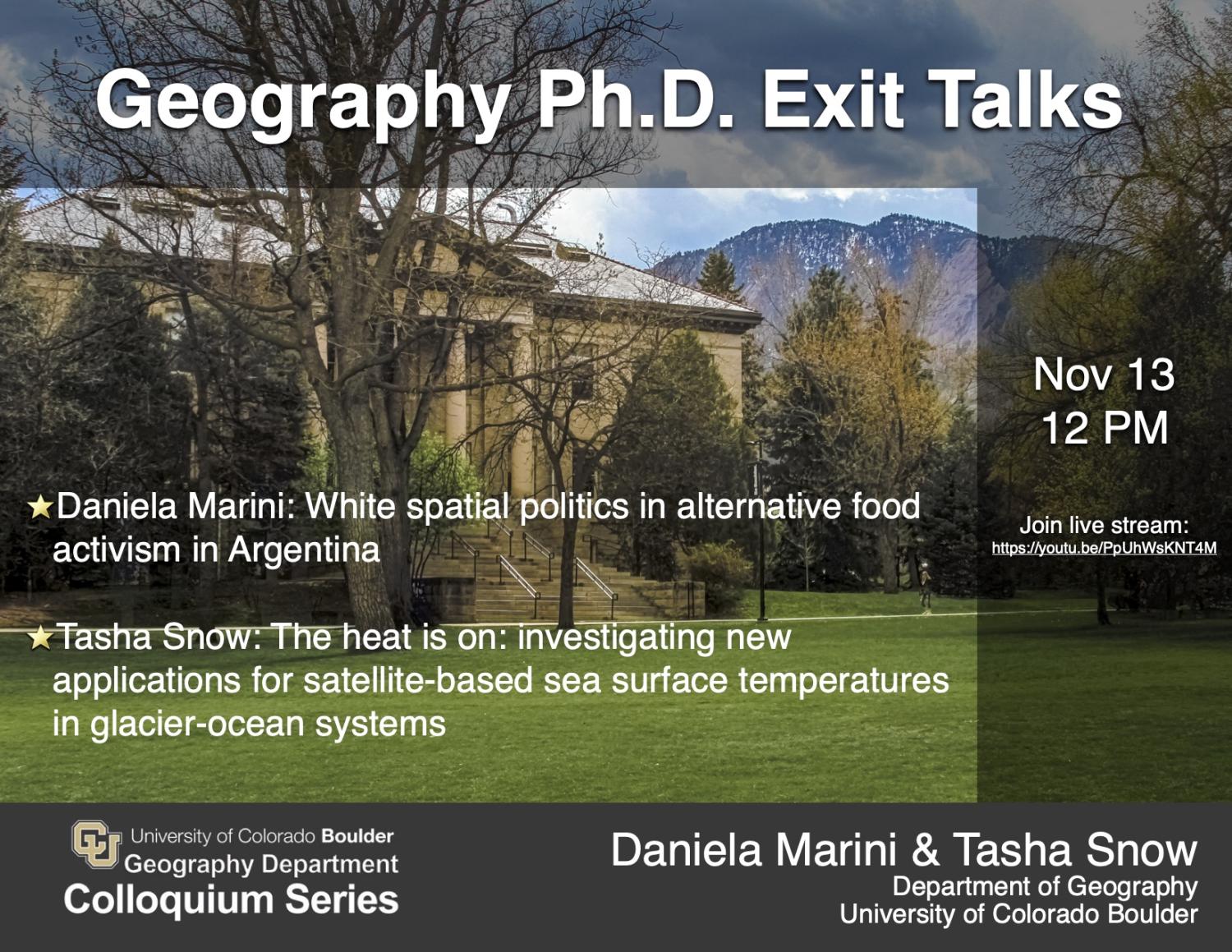Geography Ph.D. Exit Talks
Friday, November, 13th at 12:00PM MDT, 11:00AM PDT, 2:00PM EDT
Add the livestream link to your Calendar: Outlook, Google, iCal
Join the livestream >>
White spatial politics in alternative food activism in Argentina
Dr. Daniela Marini, Assistant Professor,
Integrative, Religious and Intercultural Studies Department, Grand Valley State University
Abstract
From a political ecology framework attentive to the articulated effects of race and nature, this paper addresses whiteness in alternative food activism in Argentina. Empirically, I analyze the activist work (2015 – 2018) of an agroecology organization located in Río Cuarto, an agricultural hub in central Argentina. I argue that activist work resisting pesticide drift from industrial agriculture neglect the unequal exposure to toxicity of farmworkers who fall outside racial and ethnic identifications. In so doing, agroecology advocates reinforce on-going process of racialization of the labor force while pave the way for a double standard in food production. The paper suggests a need for deeper attention to the ways in which practices of racialization work in and through ideas of nature and proper environmental relations in seemingly progressive food paradigms.
Bio
Daniela Marini is an Assistant Professor in the Integrative, Religious and Intercultural Studies Department at Grand Valley State University, Michigan. She completed her Ph.D. in geography at University of Colorado Boulder in 2020. Daniela’s dissertation, “Nature, Race and Nation in Argentina’s Soy Toxic Landscapes,” mobilizes a political ecological analysis to investigate racial dynamics in alternative food movements. The cultural politics of food and environmental activism are at the core of her research and teaching interests. In the Spring of 2020, Daniela is teaching “Food Matters” and “Interdisciplinary Research Studies” to a student body composed mostly of first generation to college students. The paper she will be presenting has been submitted for publication to the Latin American and the Caribbean Ethnic Studies (LACES) in a special issue on whiteness in Latin America.
The heat is on: investigating new applications for satellite-based sea surface temperatures in glacier-ocean systems
Tasha Snow, Ph.D. Candidate, Department of Geography,
Cooperative Institute for Research in Environmental Sciences, University of Colorado Boulder
Abstract
The Greenland Ice Sheet contributes one-quarter of global sea level rise each year, and approximately half of its loss occurs at outlet glaciers along its periphery. Antarctica’s contributions are more uncertain, but ice loss has been increasing. Glacier melting caused by interactions with relatively warm ocean water is a primary mechanism for these ice losses, and it can lead to massive ice instabilities with rapid sea level rise. Field measurements serve as the predominant method for studying these harsh and remote ocean environments but have often only been acquired within the last decade and only in a few locations around Greenland and Antarctica. Since many glaciers began to change before that period, the lack of measurements requires us to rely on an understanding of contemporary ocean processes and, from that, make inferences of past conditions to evaluate the ocean’s role in observed glacier change. Satellite-derived sea surface temperatures may provide insight into glacier-ocean interactions, but they have been historically underutilized around the ice sheets. In my dissertation, I explore the utility of sea surface temperatures in expanding ocean observations near Greenland and Antarctica. I show new ways to apply sea surface temperatures to characterize ocean currents, reconstruct surface and subsurface water temperatures, and determine the mechanisms driving warm water toward vulnerable glaciers around the Greenland and Antarctic Ice Sheets. My work suggests that sea surface temperatures, when used with other glacier-atmosphere-ocean datasets, can provide new insight into ocean and ice variability that sheds light on the phenomena that cause glacier change.


